Employees Sound Off on Goal Setting & Performance Feedback

INTRODUCTION
More than 60% of all U.S. companies today have processes in place to set individual goals with employees and to review performance against these goals periodically. Larger companies favor doing this on an annual basis, and smaller companies tend toward more frequent goal setting and feedback interactions, either quarterly or more often.
How do employees feel about these processes and the frequency with which they occur? To find out, we contracted with an independent, third-party research company to survey 5,000 U.S. employees representing all major industries and demographic categories.
The results, documented in this report, provide new information about the current state of goal setting and performance feedback across different industries and company sizes. Unlike previous research, in which we found significant differences between what employers are doing and what employees want, close alignment exists on the topic of goal setting and performance reviews.
The major differences we found are in the preferences for frequency of goal setting and review cycles among demographic groups. Baby boomers and gen Xers both favor annual cycles, whereas millennials prefer quarterly or more often.
This Trendicators Survey report is the result of research conducted by Engage2Excel’s Chief Scientific Officer, Dr. Jack Wiley. The results, summarized on the following pages, provide readers an unbiased view of employees’ perceptions of goal setting and performance feedback in today’s workplace.

Jack Wiley is an author, consultant, researcher and instructor.
For almost three decades, he has focused on two big research questions:
what employees most want and what organizational factors best promote
employee engagement, performance confidence and business success.
Download
 hbspt.cta.load(123973, 'a1941852-14d0-4b77-b081-3532f0673837', {});
hbspt.cta.load(123973, 'a1941852-14d0-4b77-b081-3532f0673837', {});
SURVEY RESULTS AT-A-GLANCE
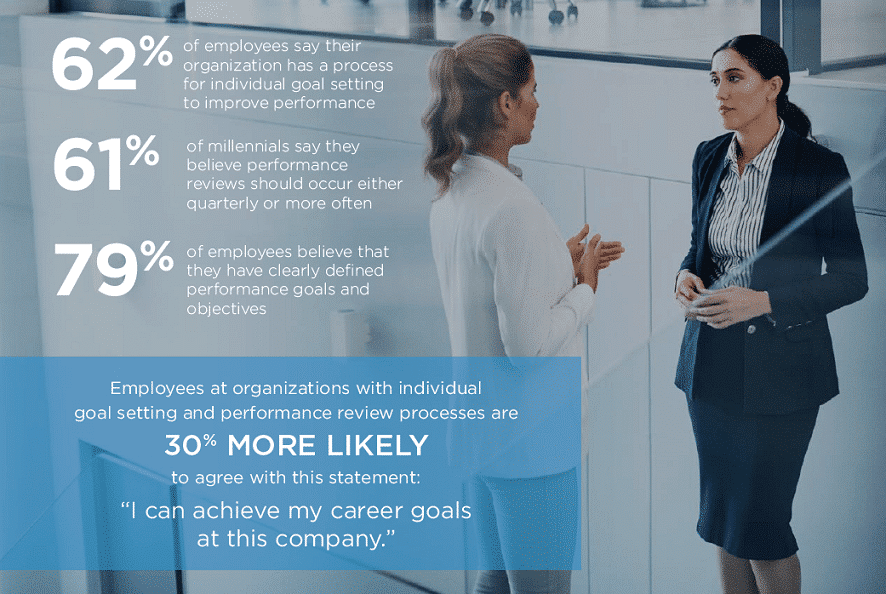
Survey Demographics
Number of Respondents: 5,000
Countries Represented: United States
Industries Represented: All major industries
Respondent Demographics: U.S. adult workers in all job types with proportionate representation of gender, age group and racial/ethnic origin
Margin of Error: 95% confidence level +/- 1.5%
Trendicators is the research division of Engage2Excel, a leading provider of employee recognition, engagement survey and talent acquisition solutions. Trendicators provides original research along with reports on insights and best practices from industry leaders and experts.
Download
 hbspt.cta.load(123973, 'a1941852-14d0-4b77-b081-3532f0673837', {});
hbspt.cta.load(123973, 'a1941852-14d0-4b77-b081-3532f0673837', {});
PREVALENCE
How common are individual goal setting and performance reviews?
More than two-thirds (69%) of respondents reported receiving a performance review within the last 12 months, and a clear majority (61%) say their organization uses an individual goal setting process to help manage employee performance. It is not surprising that highly regulated fields such as healthcare and finance rank among the sectors with the highest prevalence of these programs.
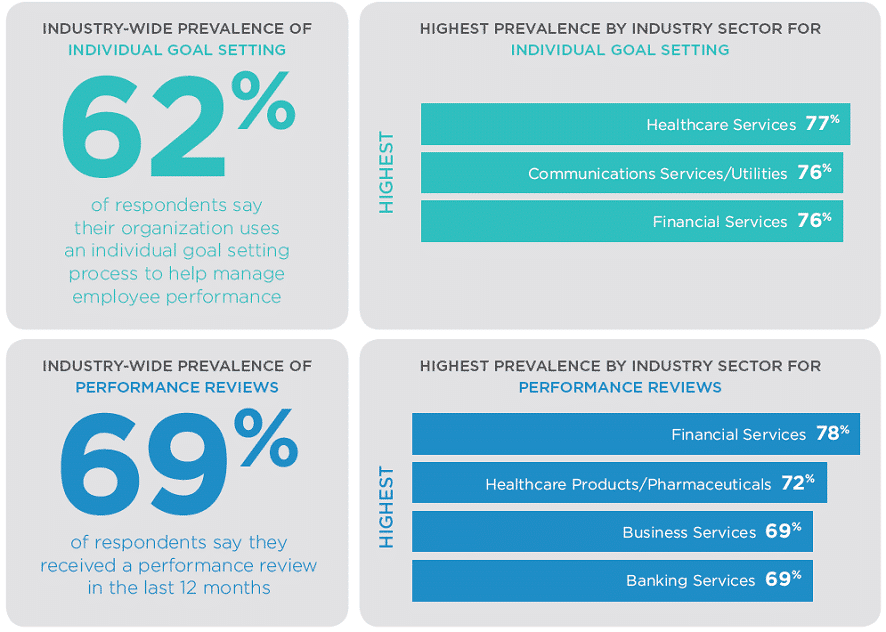
Download
 hbspt.cta.load(123973, 'a1941852-14d0-4b77-b081-3532f0673837', {});
hbspt.cta.load(123973, 'a1941852-14d0-4b77-b081-3532f0673837', {});
FREQUENCY
How often do goal setting and performance reviews take place?
Keeping up with changing business environments and customer demands remains a challenge for all organizations, managers and individuals. To more closely align the efforts of individuals with changing needs, 40% of all companies are conducting goal setting either on a quarterly or more frequent basis. Despite much discussion around changing the annual performance review process, companies with 5,000 or more employees still prefer an annual schedule for goal setting and performance feedback.
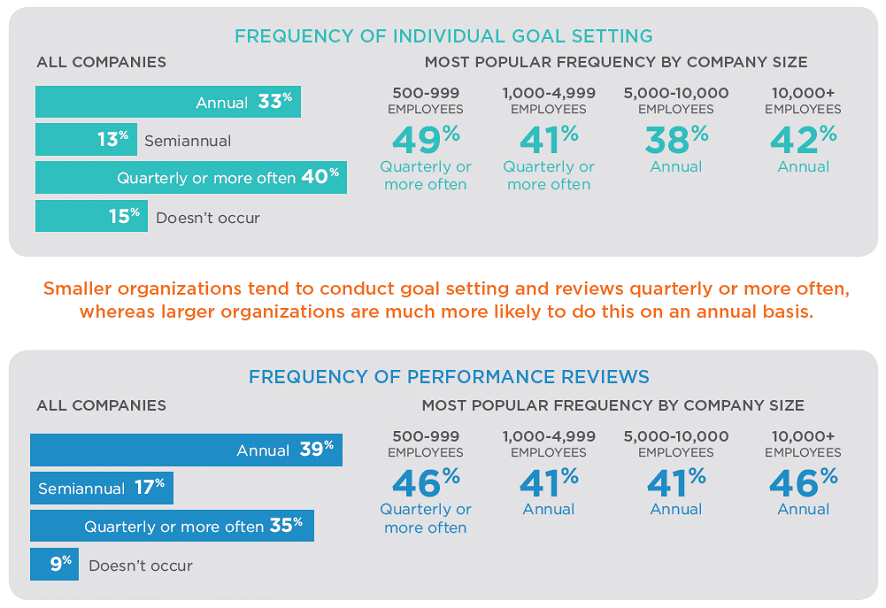
Download
 hbspt.cta.load(123973, 'a1941852-14d0-4b77-b081-3532f0673837', {});
hbspt.cta.load(123973, 'a1941852-14d0-4b77-b081-3532f0673837', {});
EMPLOYEE PREFERENCES
How often do employees want to set goals and be reviewed?
In previous surveys, we have identified significant gaps between what employers provide and what employees want (prevalence vs. preference). For goal setting and performance reviews, however, only slight differences exist between prevalence and preference among all employees—most of which fall within the survey margin of error. Significant differences do, however, exist among demographic groups. Millennials heavily favor quarterly or more frequent goal setting and review cycles, baby boomers favor annual cycles, and gen Xers are split between annual and quarterly or more frequent cycles.
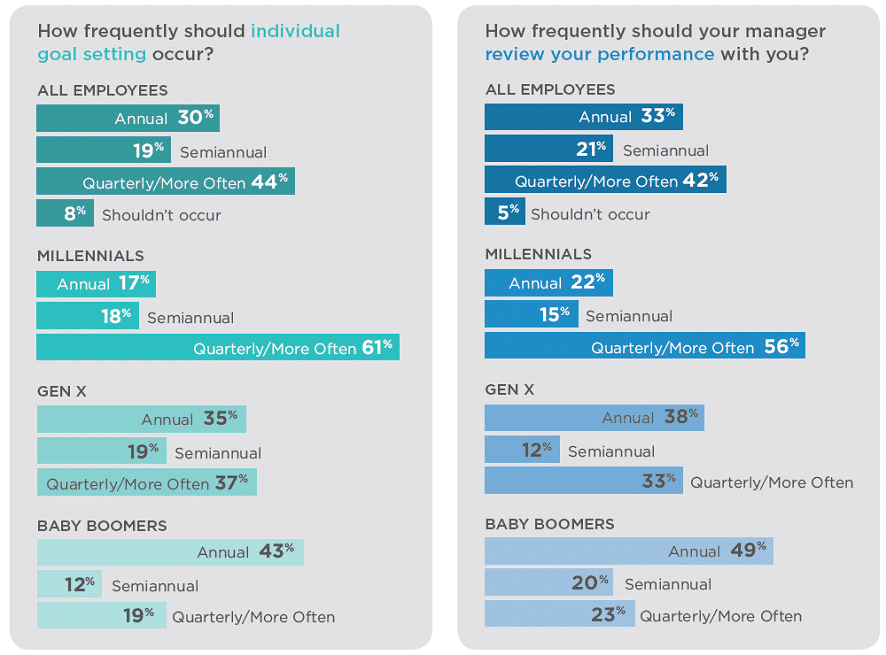
Download
 hbspt.cta.load(123973, 'a1941852-14d0-4b77-b081-3532f0673837', {});
hbspt.cta.load(123973, 'a1941852-14d0-4b77-b081-3532f0673837', {});
EMPLOYEE PERCEPTIONS
What forms of informal feedback are important to employees?
Performance reviews are important and valued by employers and employees alike. However, employees also place a high value on informal feedback. Feedback from other members of their team, for example, is considered to be as important as feedback from their manager. Nearly three-quarters (73%) of employees feel that informal feedback from their manager is more helpful than a formal performance review. And almost as many (70%) are comfortable sharing ideas with their manager on how he/she could improve their team leadership.
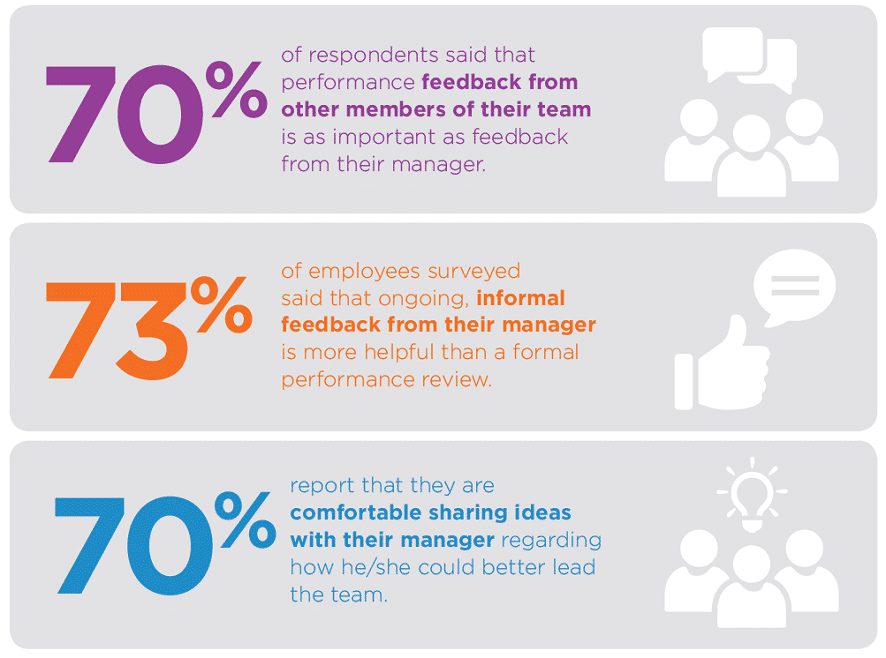
Download
 hbspt.cta.load(123973, 'a1941852-14d0-4b77-b081-3532f0673837', {});
hbspt.cta.load(123973, 'a1941852-14d0-4b77-b081-3532f0673837', {});
PROGRAM INFLUENCE
How do goal setting and reviews affect employee perceptions and attitudes?
Helping employees set goals and work towards achieving them has always made good business sense. But in times of low unemployment and rising turnover rates among younger workers, it can be a critical enabler of your organization’s future success. Employees with managers who participated in goal setting and performance feedback scored higher on a variety of key engagement indicators. Those employees are 30% more likely to believe they can achieve their career goals with their current employers and 20% more likely to tell people that they are proud of where they work. Goal setting and feedback can also contribute to closer bonds between employees and their managers and result in higher levels of discretionary effort.
Employees with goal setting and reviews score 13 to 16 percentage points higher on key engagement indicators
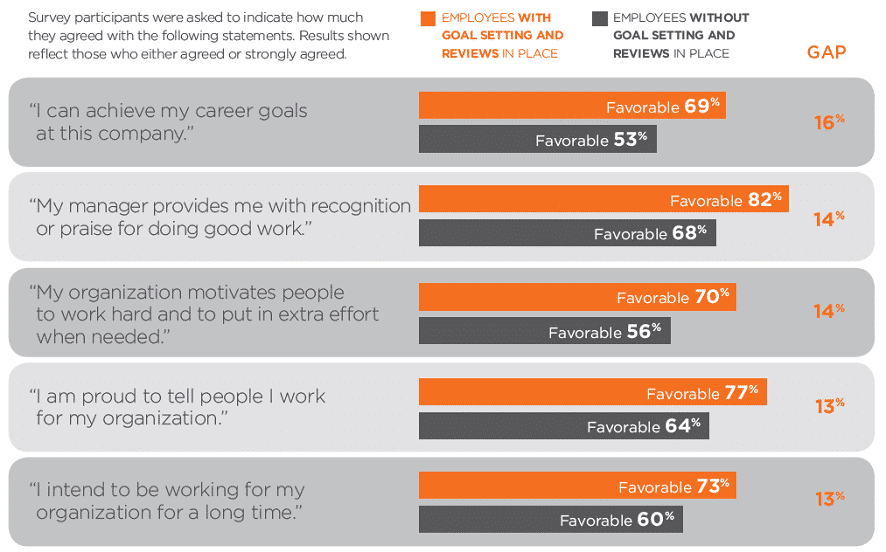
Download
 hbspt.cta.load(123973, 'a1941852-14d0-4b77-b081-3532f0673837', {});
hbspt.cta.load(123973, 'a1941852-14d0-4b77-b081-3532f0673837', {});
Five Ideas for Improving Goal Setting and Performance Feedback Experiences
Motivation and the willingness to apply discretionary effort are essential enablers for success in today’s ever-changing work environment—whether that environment is a corporate office, factory floor, design studio, call center, retail store or home office.
Every employee, no matter where they work, wants and needs to respond to changing business demands with a sense of emotional ownership and commitment. The degree to which they can do so is greatly influenced by performance management components.
If the survey results presented in the previous pages add up to anything, it’s this: employees want and need direction in setting and achieving goals, and they desire more regular, informal feedback. How can managers improve their skills in this area?
We asked a few of our favorite clients, internal experts and respected consultants to collaborate and provide us five recommendations for managers:
- Help employees align personal goals with organizational objectives.
Goal setting is often a personal and self-directed process. However, to be meaningful, employees need help in understanding how to connect their goals to the organization’s strategic business objectives. Resist the temptation to provide a script. It’s important for each employee to articulate their goals and why they matter in their own words. - Develop a sense of shared equity around goals that are specific and achievable.
While it’s critical for employees to own their goals, it is equally important for them to feel that you are a partner in their success. This may involve challenging some of their assumptions. In addition, most goals depend on certain conditions, circumstances, or other people to materialize. Help employees think through different dependencies and outcomes and be prepared for setbacks and course corrections if needed. - Provide ongoing positive reinforcement and constructive feedback.
Informal positive reinforcement and praise are powerful motivators and should be shared often. If you are unsure of an employee’s comfortability with constructive feedback, consider asking how comfortable he or she is, on a 1-10 scale, receiving it. The answer can help you tailor your style and approach. Lastly, encourage feedback to be two-way so that you can improve your management skills. - Create a feedback culture.
70% of employees say performance feedback from other members of their team is as important as feedback from their manager. Provide forums for team members to comfortably provide informal feedback to each other. - Recognize achievement and success.
Committing to goals and accomplishing them is important. Recognize and celebrate employees who achieve both large and small successes. Recognition justifies to the employee that their hard work is appreciated.
Download
 hbspt.cta.load(123973, 'a1941852-14d0-4b77-b081-3532f0673837', {});
hbspt.cta.load(123973, 'a1941852-14d0-4b77-b081-3532f0673837', {});